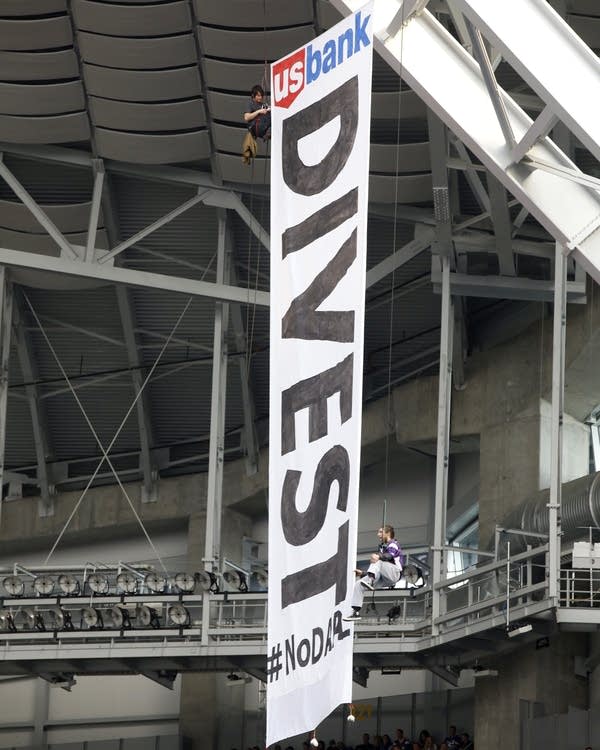Protest appeared to misstate U.S. Bank's role in Dakota Access pipeline

Go Deeper.
Create an account or log in to save stories.
Like this?
Thanks for liking this story! We have added it to a list of your favorite stories.
On New Year's Day, as the Minnesota Vikings were playing the Chicago Bears at U.S. Bank Stadium, protesters climbed into the rafters and hung a banner urging U.S. Bank to "divest" from the Dakota Access oil pipeline.
On that and other occasions, opponents of the pipeline have cast U.S. Bank and other banks as "investors" in the project. But U.S. Bank is arguably better described as a lender, or potential lender, to one or more companies working on the pipeline.
The pipeline project, which has inspired a months-long occupation of federal land by Native American protesters and their supporters, remains a point of passionate controversy. Critics say a break in the line could send Bakken crude oil gushing into the river, fouling the water supply for the Standing Rock Sioux Reservation just downstream.
The Army Corps of Engineers recently denied a permit for the pipeline to cross the Missouri River near the reservation. It's uncertain whether that decision will be reversed when President-elect Donald Trump takes office.
Turn Up Your Support
MPR News helps you turn down the noise and build shared understanding. Turn up your support for this public resource and keep trusted journalism accessible to all.

The bank's financial ties to the project are fuzzy, as is the importance of any U.S. Bank lending in completing the pipeline. U.S. Bank is among many banks that have offered financing to Energy Transfer Partners, or ETP, one of the entities responsible for developing, owning and operating the Bakken Pipeline Project, which includes the Dakota Access Pipeline.
Spokesman Dana Ripley would not discuss U.S. Bank's relationship with ETP, the extent to which it has lent money to ETP, or the bank's role — if any — in funding the pipeline. Citing the need to keep customer relationships private, Ripley declined to discuss the bank's relationship with ETP over the years.
ETP did not respond to inquiries about its dealings with U.S. Bank.
Filings with the Securities and Exchange Commission indicate U.S. Bank is among a group of 24 banks that as of February 2015 had agreed to extend up to $3.75 billion in credit to ETP. It's unclear how much of that money ETP has chosen to borrow or, or how it might have used the money.
U.S. Bank committed to lend up to $175 million. Among the banks making equal or greater commitments were Wells Fargo, Bank of America, the Royal Bank of Scotland and JP Morgan Chase.
An SEC filing shows U.S. Bank has also extended a $100 million line of credit to Sunoco Logistics, which is involved with the pipeline project. Such lending is minor for U.S. Bank; at the end of last October, it had $271 billion in loans on its books.
Whether U.S. Bank could terminate any financing it may have provided to Energy Transfer Partners would depend on the terms and conditions of the loan. Details are unlikely to be made public.
Since at least 2010, U.S. Bank has served as a trustee in relation to debt issued by Energy Transfer Partners. A trustee handles administrative responsibilities, such as monitoring interest payments to bondholders and communicating with investors. The trustee is compensated for that.
U.S. Bank has also been a trustee for debt issued by other parties connected with the Dakota Access pipeline: Sunoco Logistics and Enbridge Energy Partners.




